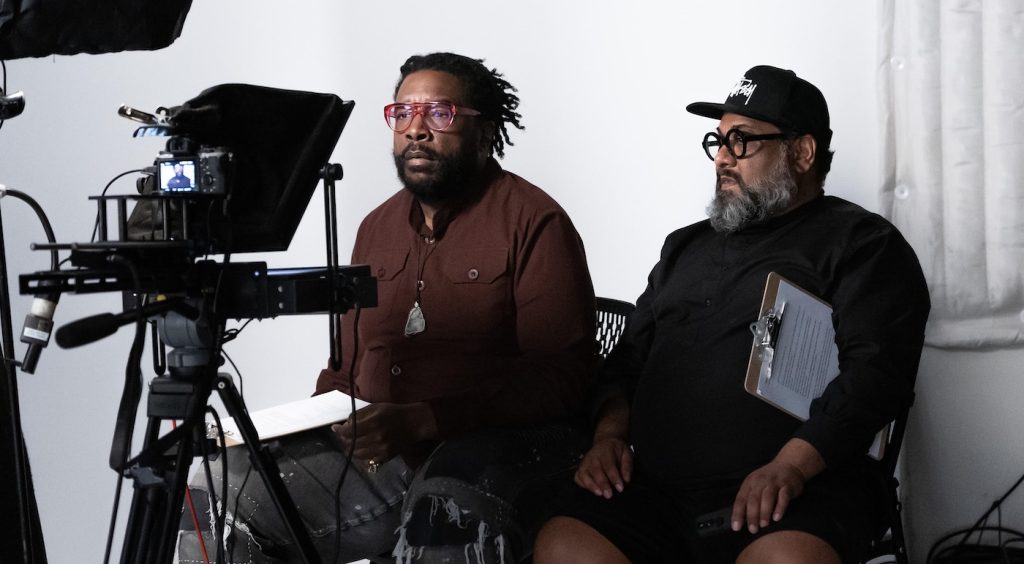Producer Joseph Patel Explores Sly Stone’s Life & Legacy in “Sly Lives! (aka The Burden of Black Genius)”
Prodigiously gifted songwriter/singer/arranger/producer/bandleader/keyboardist/guitarist Sly Stone gets his well-deserved close-up in documentary makers Joseph Patel and Ahmir “Questlove” Thompson‘s SLY LIVES! (aka The Burden of Black Genius). After earning an Academy Award for Summer of Soul, producer Patel and director QuestLove decided to deep-dive into the life and music of the man whose multi-racial band once thrilled hippies and Black audiences alike with ingenious funk-pop anthems including “I Want to Take You Higher,” “Dance to the Music,” “Everyday People,” “Stand!” “Thank you (Falettinme Be Mice Elf),” “Hot Fun in the Summertime,” “Family Affair,” and “If You Want Me to Stay.”
Stone, now 82, followed the 1967-1975 hit parade with several decades of drug abuse. “There have been books and amateur docs that reveled in Sly Stone’s downfall,” says Patel. By contrast, he explains, “We wanted to tell his story with empathy. Can you imagine being 26 years old, a Black artist headlining Woodstock, being on the cover of Rolling Stone, Black audiences and white audiences are both looking to you like you’ve solved race relations with your music? What kind of pressure that must have been for him!”
Sly Lives!, now streaming on Hulu after its Sundance Film Festival debut last month, presents rare concert footage interwoven with interviews featuring bandmates, members of Stone’s family, and contemporary Black musicians who now encounter the same kinds of pressures that Sly Stone faced in his heyday.
Speaking from his home in Brooklyn, Patel, who spent two and a half years on Sly Lives!, talks about how Sly Stone grappled with the burden of Black genius.
Archival footage in this film documents peak Sly Stone and his great band in such an exhilarating way, but then…
The movie intentionally starts out exhilarating and then gets sad, but hopefully, it ends on an optimistic note—he’s still with us!
Sly Stone seemed to be supremely confident on stage, so it’s surprising to learn in the film that he suffered from intense stage fright.
We talked to Sly’s former assistant slash girlfriend, Stephani Owens, about that. She’d say to Sly, “How can you be anxious? You do this all the time?” But then you also have [ex-girlfriend/singer] Ruth Copeland’s story where Sly’s at a venue, and he’s in the bathroom for an hour and a half, probably quelling his nerves with drugs because it’s so hard for him to walk on stage.

Sly Stone himself was not interviewed for this movie. Why is that?
We couldn’t interview him because of health concerns. Instead, we talked to artists like D’Angelo. When Ahmir played drums in his band on the 2000 Voodoo tour [named after the platinum-selling album], he witnessed D’Angelo struggling to come out on stage every night and perform “How Does It Feel” with his shirt off and a perfect body. D’Angelo hadn’t done an interview in 10 years, so for him to admit that he’d gone through feelings of shame and guilt and anxiety—that was jaw-dropping. Q-Tip knows what it’s like to have people expect you to do a thing you don’t want to do anymore. Andre 2000—all his fans want him to rap, but he’s like, “No, I know how this can go if I rap and my heart’s not in it. So I’m going to go play the flute.” These artists all sort of serve as proxies for Sly and this idea of the burden of Black genius.
Before the drugs took over, Sly Stone crafted incredibly catchy songs with fantastic arrangements. For music nerds, it’s a treat to hear him working with the Family Stone to perfect these tracks in the studio. How did you get ahold of that material?
Sony was very gracious in letting us into their archives so we could listen to studio sessions. When we pulled reels of Sly and the Family Stone recording their debut in ’67, it was fascinating to hear his confidence in directing the engineer and the band members. “Everyday People” take one — you hear Rose Stone at the piano, you hear Sly telling Jerry Martini and Cynthia Robinson, “Your horns aren’t right.” You hear him saying, “Do it again,” over and over. You can tell he hears the music in his head and has a singular creative focus on getting it right.
The documentary also highlights Sly Stone’s impact on Black artists like Chic leader Niles Rodger and Janet Jackson producers Jimmy Jam and Terry Lewis, who talk about sampling a guitar riff from “Thank you (Falettinme Be Mice Elf)” and using it on “Rhythm Nation.”
Our intent was not just to tell you that Sly was a great musician but to show you how he did it. What better way to do that then to have Jimmy Jam and Terry Lewis and Niles Rodger, musicians who are hitmakers themselves and were directly influenced by Sly, laying down the craft for you.
Ahmir interviewed many top Black artists for Sly Lives! Was it easy getting musicians to participate?
Yes and no. I can’t name names, but two artists canceled on us the day of or the day before their interviews. One of them called Ahmir at four o’clock in the morning and said, “I’m not coming.” I freaked out because we had the room, we had the crew, we’d spent this money, but Ahmir was like, “There’s a bigger idea here about people who self-sabotage because of their fear of success, and these artists are sort of living that in real-time.” One reason Ahmir wanted to make this film was to show his peers that Sly went through the same thing. Other artists go through the same thing. They don’t need to feel alone.
On the subject of self-sabotage, this film shows how drug use and isolation escalate when Sly moves from San Francisco to L.A. and holes up in the attic of this big BelAir mansion for hours at a time.
As Sly’s old manager Stephen Paley told us, he didn’t really need the band anymore, and you see it in the song titles. It’s not “We” and “Us” anymore; it’s “I” and “Me” song titles. What does that isolation do to people? [Writer/filmmaker] dream hampton says the biggest way people self-sabotage is by ruining relationships, and here we are seeing that play out on the screen.
You guys include Family Stone concert footage never seen before. Where did you find it?
We have two great archival producers, Matthew Van Deventer and Bianca Cervantes, who helped a lot. There’s also a pair of twins in the Netherlands who’ve been collecting Sly stuff for 35 years, a guy in Germany, a guy named Neal Austinson [Stone’s former road manager], who had stuff that hadn’t been touched in a decade. It was about ingratiating ourselves, talking shop, sort of proving our aim was true. Summer of Soul is a good calling card to have. Then we digitized all this and tracked down who owned the rights. The last thing got cleared only about two weeks before Sundance. This movie took two and a half years, and we used every ounce of that time frame
Black guitarist Vernon Reid, whose band Living Color, like Sly and the Family Stone, also appealed to white audiences, has the last word in this documentary. How did that come about?
I gave Vernon ten pages of homework, songs to listen to and videos to watch, so he really came prepared. We’d been circling around this idea of “Sly Lives!” as the title, partly because we weren’t sure he’d be alive by the time we finished. So after we’d interviewed Vernon, he said “I want to say one more thing.” We were like, “Cool.” And he goes into this monologue about how Sly Stone gave us so much, and then he ends by saying “Sly lives.” Ahmir and I looked at each other in the studio, and we were like, “Oh my god, Vernon just landed the plane for us on the title.
Sly Stone’s children add a personal dimension to the story. Did you enjoy listening to their insights?
One of my favorite lines in the movie is when Sly Stone’s daughter Novena said he likes pizzas with all the toppings and westerns and cars, “like a standard old Black man.” If you told 26-year-old Sly that he would be 82 and his daughter would describe him as a standard old Black man, he’d take that in a heartbeat.
You filmed in New York, Los Angeles, Sacramento, San Francisco, and Minneapolis. Were you mindful of how this project economically contributed to the filmmaking community, including the below-the-line crew?
Of course. It’s a miracle anything gets made and released into the world. That doesn’t happen unless you have an incredible team of people, in roles big and small, working towards a common goal. Movies are magic, and all of us are deeply appreciative that we get to do this for a living. I think a lot of us would do this work for free but it’s nice to get paid and to pay other people to be a part of it.
Featured image: SLY LIVES! (AKA THE BURDEN OF BLACK GENIUS – “SLY LIVES! (aka The Burden of Black Genius)” examines the life and legacy of Sly & The Family Stone, the groundbreaking band led by the charismatic and enigmatic Sly Stone. The film captures the band’s rise, reign and subsequent fadeout while shedding light on the unseen burden that comes with success for Black artists in America. (Courtesy of Disney)



